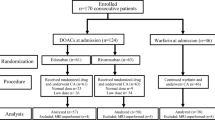Abstract
Direct oral anticoagulants (DOACs) are superior to warfarin in reduction of the intracranial bleeding risk. The aim of the present study was to assess whether early DOAC introduction (1–3 days after onset) in stroke patients with non-valvular atrial fibrillation (nVAF) may be safe and effective, compared with DOAC introduction after 4–7 days. We conducted a prospective analysis based on data collected from 147 consecutive nVAF patients who started DOAC within 7 days after stroke onset. In all patients, we performed pre-DOAC CT scan 24–36 h after onset and follow-up CT scan at 7 days after DOAC introduction. Outcome measures were post-DOAC intracranial bleeding (new any intracerebral hemorrhage (ICH) in patients with pre-DOAC infarct without hemorrhagic transformation (HT) or expansion of ICH in patients with pre-DOAC infarct with asymptomatic HT) and post-DOAC recurrent ischemic stroke (any new ischemic infarct) on follow-up CT scan. 97 patients started DOAC after 1–3 days and 50 patients started DOAC after 4–7 days. On pre-DOAC CT scan, 132 patients had an infarct without HT and 15 an infarct with asymptomatic HT. On follow-up CT scan, new any ICH was noted in seven patients (asymptomatic in 6) and asymptomatic expansion of ICH in one patient. We found no association between early DOAC introduction and intracranial bleeding. Large infarct remained the only independent predictor of post-DOAC intracranial bleeding. No patients suffered recurrent ischemic stroke after DOAC introduction. Early DOAC introduction might be safe in carefully selected patients with nVAF who experience small- and medium-sized cardioembolic ischemic strokes. Further investigation will be needed.

Similar content being viewed by others
References
Hart RG, Coull BM, Hart D (1983) Early recurrent embolism associated with nonvalvular atrial fibrillation: a retrospective study. Stroke 14:688–693
Hornig CR, Bauer T, Simon C, Trittmacher S, Dorndorf W (1993) Hemorrhagic transformation in cardioembolic cerebral infarction. Stroke 24:465–468
Abdul-Rahim AH, Fulton RL, Frank B et al (2015) Association of improved outcome in acute ischaemic stroke patients with atrial fibrillation who receive early antithrombotic therapy: analysis from VISTA. Eur J Neurol 22:1048–1055
Sardar P, Chatterjee S, Wu WC et al (2013) New oral anticoagulants are not superior to warfarin in secondary prevention of stroke or transient ischemic attacks, but lower the risk of intracranial bleeding: insights from a meta-analysis and indirect treatment comparisons. PLoS One 25(8):e77694
Shibazaki K, Kimura K, Aoki J, Saji N, Sakai K (2013) Early initiation of new oral anticoagulants in acute stroke and TIA patients with nonvalvular atrial fibrillation. J Neurol Sci 331:90–93
Nomura E, Ohshita T, Imamura E et al (2015) Early administration of non-vitamin K antagonist oral anticoagulants for acute ischemic stroke patients with atrial fibrillation in comparison with warfarin mostly combined with heparin. Circ J 79:862–866
Whiteley WN, Adams HP Jr, Bath PM et al (2013) Targeted use of heparin, heparinoids, or low-molecular-weight heparin to improve outcome after acute ischaemic stroke: an individual patient data meta-analysis of randomised controlled trials. Lancet Neurol 12:539–545
Álvarez-Sabín J, Maisterra O, Santamarina E, Kase CS (2013) Factors influencing haemorrhagic transformation in ischaemic stroke. Lancet Neurol 12:689–705
Kono S, Yamashita T, Deguchi K et al (2014) Rivaroxaban and apixaban reduce hemorrhagic transformation after thrombolysis by protection of neurovascular unit in rat. Stroke 45:2404–2410
Kono S, Deguchi K, Omote Y et al (2014) Reducing hemorrhagic complication by dabigatran via neurovascular protection after recanalization with tissue plasminogen activator in ischemic stroke of rat. J Neurosci Res 92:46–53
Akiyama H, Uchino K, Hasegawa Y (2015) Characteristics of symptomatic intracranial hemorrhage in patients receiving non-vitamin K antagonist oral anticoagulant therapy. PLoS One 10:e0132900
Hagii J, Tomita H, Metoki N et al (2014) Characteristics of intracerebral hemorrhage during rivaroxaban treatment: comparison with those during warfarin. Stroke 45:2805–2807
Author information
Authors and Affiliations
Corresponding author
Rights and permissions
About this article
Cite this article
Cappellari, M., Carletti, M., Danese, A. et al. Early introduction of direct oral anticoagulants in cardioembolic stroke patients with non-valvular atrial fibrillation. J Thromb Thrombolysis 42, 393–398 (2016). https://doi.org/10.1007/s11239-016-1393-9
Published:
Issue Date:
DOI: https://doi.org/10.1007/s11239-016-1393-9




